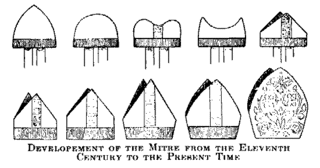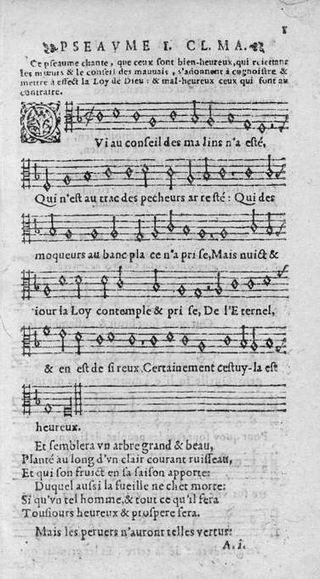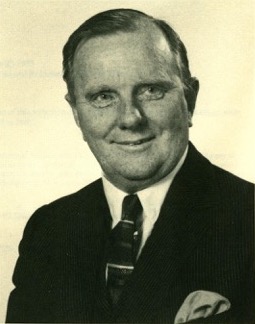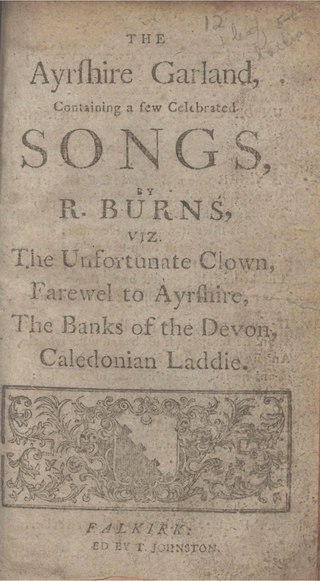
An episcopal polity is a hierarchical form of church governance in which the chief local authorities are called bishops. It is the structure used by many of the major Christian Churches and denominations, such as the Catholic, Eastern Orthodox, Oriental Orthodox, Church of the East, Anglican, Lutheran and Methodist churches or denominations, and other churches founded independently from these lineages.

Presbyterianism is a part of the Reformed tradition within Protestantism that broke from the Roman Catholic Church. Presbyterian churches derive their name from the presbyterian form of church government by representative assemblies of elders. Many Reformed churches are organised this way, but the word Presbyterian, when capitalized, is often applied to churches that trace their roots to the Church of Scotland or to English Dissenter groups that formed during the English Civil War.
The Scottish Episcopal Church is the ecclesiastical province of the Anglican Communion in Scotland.

Closed communion is the practice of restricting the serving of the elements of Holy Communion to those who are members in good standing of a particular church, denomination, sect, or congregation. Though the meaning of the term varies slightly in different Christian theological traditions, it generally means that a church or denomination limits participation either to members of their own church, members of their own denomination, or members of some specific class. This restriction is based on various parameters, one of which is baptism. See also intercommunion.

The Westminster Assembly of Divines was a council of divines (theologians) and members of the English Parliament appointed from 1643 to 1653 to restructure the Church of England. Several Scots also attended, and the Assembly's work was adopted by the Church of Scotland. As many as 121 ministers were called to the Assembly, with nineteen others added later to replace those who did not attend or could no longer attend. It produced a new Form of Church Government, a Confession of Faith or statement of belief, two catechisms or manuals for religious instruction, and a liturgical manual, the Directory for Public Worship, for the Churches of England and Scotland. Confession and catechisms were adopted as doctrinal standards in the Church of Scotland and other Presbyterian churches, where they remain normative. Amended versions of the Confession were also adopted in Congregational and Baptist churches in England and New England in the seventeenth and eighteenth centuries. The Confession became influential throughout the English-speaking world, but especially in American Protestant theology.

The history of the Anglican Communion may be attributed mainly to the worldwide spread of British culture associated with the British Empire. Among other things the Church of England spread around the world and, gradually developing autonomy in each region of the world, became the communion as it exists today.

Exclusive psalmody is the practice of singing only the biblical Psalms in congregational singing as worship. Today it is practised by several Protestant, especially Reformed denominations. Hymns besides the Psalms have been composed by Christians since the earliest days of the church, but psalms were preferred by the early church and used almost exclusively until the end of the fourth century. During the Protestant Reformation, Martin Luther and many other reformers, including those associated with the Reformed tradition, used hymns as well as psalms, but John Calvin preferred the Psalms and they were the only music allowed for worship in Geneva. This became the norm for the next 200 years of Reformed worship. Hymnody became acceptable again for the Reformed in the middle of the nineteenth century, though several denominations, notably the Reformed Presbyterians, continue the practice of exclusive psalmody.

In numismatics, token coins or trade tokens are coin-like objects used instead of coins. The field of token coins is part of exonumia and token coins are token money. Their denomination is shown or implied by size, color or shape. They are often made of cheaper metals like copper, pewter, aluminium, brass and tin, or non-metals like bakelite, leather and porcelain.

The Five Articles of Perth was an attempt by King James VI of Scotland to impose practices on the Church of Scotland in an attempt to integrate it with those of the Church of England. This move was unpopular with those Scots who held Reformed views on worship, and with those who supported presbyterian church governance.

As of the 2011 census, Christianity was the largest religion in Scotland, chosen by 53.8% of the Scottish population identifying when asked: "What religion, religious denomination or body do you belong to?" This represented a decline from the 2001 figure of 65.1%.
Presbyterianism in England is practised by followers of the Reformed tradition within Protestantism who practise the Presbyterian form of church government. Dating in England as a movement from 1588, it is distinct from Continental and Scottish forms of Presbyterianism. The Unitarian historian Alexander Gordon (1841-1931) stated that, whereas in Scotland, church government is based on a meeting of delegates, in England the individual congregation is the primary body of government. This was the practice in Gordon's day, however, most of the sixteenth and seventeenth century English theoreticians of Presbyterianism, such as Thomas Cartwright, John Paget, the Westminster Assembly of Divines and the London Provincial Assembly, envisaged a Presbyterian system composed of congregations, classes and synods. Historically Presbyterians in England were subsumed into the United Reformed Church in 1972. In more recent years the Evangelical Presbyterian Church in England and Wales and the International Presbyterian Church have seen modest growth in England.

Philip Edgcumbe Hughes (1915–1990) was an Anglican clergyman and New Testament scholar whose life spanned four continents: Australia, where he was born; South Africa, where he spent his formative years; England, where he was ordained; and the United States, where he died in 1990, aged 75.

Church architecture in Scotland incorporates all church building within the modern borders of Scotland, from the earliest Christian structures in the sixth century until the present day. The early Christian churches for which there is evidence are basic masonry-built constructions on the west coast and islands. As Christianity spread, local churches tended to remain much simpler than their English counterparts. By the eighth century more sophisticated ashlar block-built buildings began to be constructed. From the eleventh century, there were larger and more ornate Romanesque buildings, as with Dunfermline Abbey and St Magnus Cathedral in Orkney. From the twelfth century the introduction of new monastic orders led to a boom in ecclesiastical building, often using English and Continental forms. From the thirteenth century elements of the European Gothic style began to appear in Scotland, culminating in buildings such as Glasgow Cathedral and the rebuilt Melrose Abbey. Renaissance influences can be seen in a move to a low-massive style that was probably influenced by contacts with Italy and the Netherlands.

Music in early modern Scotland includes all forms of musical production in Scotland between the early sixteenth century and the mid-eighteenth century. In this period the court followed the European trend for instrumental accompaniment and playing. Scottish monarchs of the sixteenth century were patrons of religious and secular music, and some were accomplished musicians. In the sixteenth century the playing of a musical instrument and singing became an expected accomplishment of noble men and women. The departure of James VI to rule in London at the Union of Crowns in 1603, meant that the Chapel Royal, Stirling Castle largely fell into disrepair and the major source of patronage was removed from the country. Important composers of the early sixteenth century included Robert Carver and David Peebles. The Lutheranism of the early Reformation was sympathetic to the incorporation of Catholic musical traditions and vernacular songs into worship, exemplified by The Gude and Godlie Ballatis (1567). However, the Calvinism that came to dominate Scottish Protestantism led to the closure of song schools, disbanding of choirs, removal of organs and the destruction of music books and manuscripts. An emphasis was placed on the Psalms, resulting in the production of a series of Psalters and the creation of a tradition of unaccompanied singing.
Reformed worship is religious devotion to God as conducted by Reformed or Calvinistic Christians, including Presbyterians. Despite considerable local and national variation, public worship in most Reformed and Presbyterian churches is governed by the Regulative principle of worship.

Scottish religion in the eighteenth century includes all forms of religious organisation and belief in Scotland in the eighteenth century. This period saw the beginnings of a fragmentation of the Church of Scotland that had been created in the Reformation and established on a fully Presbyterian basis after the Glorious Revolution. These fractures were prompted by issues of government and patronage, but reflected a wider division between the Evangelicals and the Moderate Party. The legal right of lay patrons to present clergymen of their choice to local ecclesiastical livings led to minor schisms from the church. The first in 1733, known as the First Secession and headed by figures including Ebenezer Erskine, led to the creation of a series of secessionist churches. The second in 1761 led to the foundation of the independent Relief Church.

Scottish religion in the nineteenth century includes all forms of religious organisation and belief in Scotland in the 19th century. This period saw a reaction to the population growth and urbanisation of the Industrial Revolution that had undermined traditional parochial structures and religious loyalties. The established Church of Scotland reacted with a programme of church building from the 1820s. Beginning in 1834 the "Ten Years' Conflict" ended in a schism from the established Church of Scotland led by Dr Thomas Chalmers known as the Great Disruption of 1843. Roughly a third of the clergy, mainly from the North and Highlands, formed the separate Free Church of Scotland. The evangelical Free Church and other secessionist churches grew rapidly in the Highlands and Islands and urban centres. There were further schisms and divisions, particularly between those who attempted to maintain the principles of Calvinism and those that took a more personal and flexible view of salvation. However, there were also mergers that cumulated in the creation of a United Free Church in 1900 that incorporated most of the secessionist churches.

Church music in Scotland includes all musical composition and performance of music in the context of Christian worship in Scotland, from the beginnings of Christianisation in the fifth century, to the present day. The sources for Scottish Medieval music are extremely limited due to factors including a turbulent political history, the destructive practices of the Scottish Reformation, the climate and the relatively late arrival of music printing. In the early Middle Ages, ecclesiastical music was dominated by monophonic plainchant, which led to the development of a distinct form of liturgical Celtic chant. It was superseded from the eleventh century by more complex Gregorian chant. In the High Middle Ages, the need for large numbers of singing priests to fulfill the obligations of church services led to the foundation of a system of song schools, to train boys as choristers and priests. From the thirteenth century, Scottish church music was increasingly influenced by continental developments. Monophony was replaced from the fourteenth century by the Ars Nova consisting of complex polyphony. Survivals of works from the first half of the sixteenth century indicate the quality and scope of music that was undertaken at the end of the Medieval period. The outstanding Scottish composer of the first half of the sixteenth century was Robert Carver, who produced complex polyphonic music.

Music of Scotland in the eighteenth century includes all forms of music made in Scotland, by Scottish people, or in forms associated with Scotland, in the eighteenth century. Growing divisions in the Scottish kirk between the Evangelicals and the Moderate Party resulted in attempt to expand psalmondy to include hymns the singing of other scriptural paraphrases.

The history of popular religion in Scotland includes all forms of the formal theology and structures of institutional religion, between the earliest times of human occupation of what is now Scotland and the present day. Very little is known about religion in Scotland before the arrival of Christianity. It is generally presumed to have resembled Celtic polytheism and there is evidence of the worship of spirits and wells. The Christianisation of Scotland was carried out by Irish-Scots missionaries and to a lesser extent those from Rome and England, from the sixth century. Elements of paganism survived into the Christian era. The earliest evidence of religious practice is heavily biased toward monastic life. Priests carried out baptisms, masses and burials, prayed for the dead and offered sermons. The church dictated moral and legal matters and impinged on other elements of everyday life through its rules on fasting, diet, the slaughter of animals and rules on purity and ritual cleansing. One of the main features of Medieval Scotland was the Cult of Saints, with shrines devoted to local and national figures, including St Andrew, and the establishment of pilgrimage routes. Scots also played a major role in the Crusades. Historians have discerned a decline of monastic life in the late medieval period. In contrast, the burghs saw the flourishing of mendicant orders of friars in the later fifteenth century. As the doctrine of Purgatory gained importance the number of chapelries, priests and masses for the dead within parish churches grew rapidly. New "international" cults of devotion connected with Jesus and the Virgin Mary began to reach Scotland in the fifteenth century. Heresy, in the form of Lollardry, began to reach Scotland from England and Bohemia in the early fifteenth century, but did not achieve a significant following.



















